June 21, 2025 | 01:49 GMT +7
June 21, 2025 | 01:49 GMT +7
Hotline: 0913.378.918
June 21, 2025 | 01:49 GMT +7
Hotline: 0913.378.918
Fisheries have long been considered a key industry in the southern province of Tien Giang, particularly white leg shrimp farming.
To develop farming more sustainably, the Tien Giang Province’s Department of Science and Technology has recently researched three lines of probiotics from beneficial microbial strains to replace antibiotics. It is a feed treatment product, a water treatment product and a pond bottom treatment product. The research is led by Nguyen Phuoc Ai from the Centre for Engineering and Biotechnology under the department.
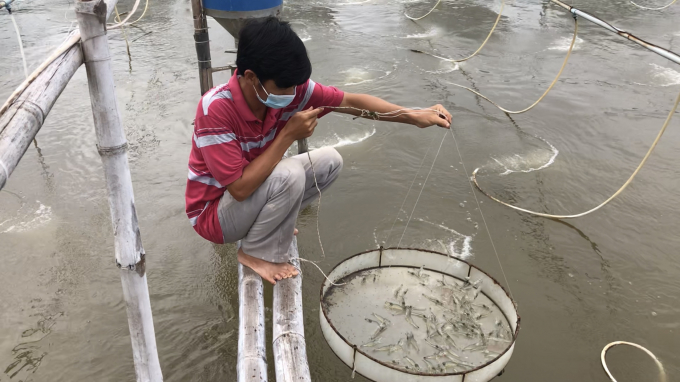
Bioproducts are used in white leg shrimp farming in Tien Giang Province. Photo: Minh Dam.
The research results show that the combination of three treatment processes on environment and feed with the bioproducts and indigenous microorganisms trains into shrimp ponds helped stabilize pond water quality.
At the same time, they helped reduce the biochemical oxygen demand indicators (BOD, COD) and suspended solids content. They also improved the settling process of ponds and reduced the volume of sludge in shrimp ponds. Most importantly, shrimps increase their disease resistance, getting common diseases less, thereby increasing profits for shrimp farmers.
Ai said that farmers mixed one litre of feed treatment product for ten kg of feed, continuously feeding shrimps for ten days a month.
After mixing, farmers must wait for 10-15 minutes and then feed the shrimps. Farmers feed shrimp throughout the growing season until harvest. The amount of food is about four to five per cent of shrimp weight. When feeding shrimp, farmers need to spread it evenly.
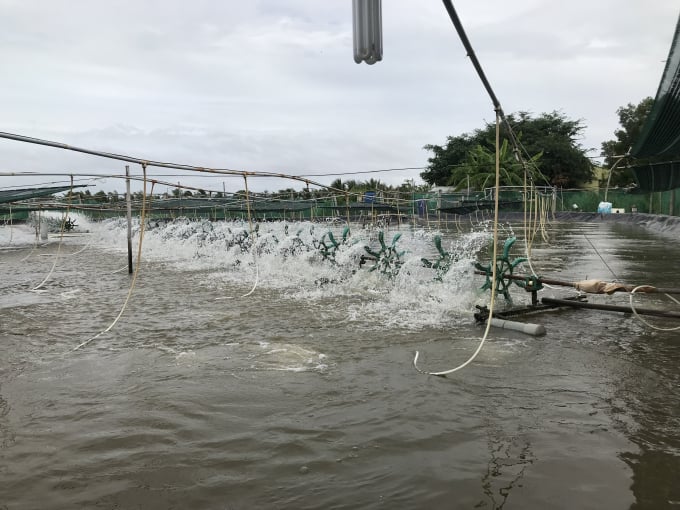
Bioproducts for treating water and pond bottom help to decompose organic matter in the water – a factor that pollutes the water environment, decomposes dead algae and reduce the increases of pond bottom sludge. Photo: Minh Dam.
To treat the pond bottom, it is necessary to use two kilos of bioproduct for an area of 1,200 sq.m. The pond needs to be treated weekly. Dosage may vary depending on the design of the pond, the composition of the pond water, the water volume and the water storage time of the pond.
For water treatment, a litre of inoculant water is used for a 1,200- sq.m pond. The process is taken weekly. The inoculant water is distributed evenly on the pond.
“A well-managed shrimp pond with the periodic use of probiotics will help control harmful bacteria and toxin levels, keeping the pond environment in a stable state. Good water quality will help shrimp grow healthy,” he said.
Probiotics replace antibiotics in shrimp farming. Biosafety shrimp farming needs to be developed from hatcheries to grow-out ponds to prevent and limit the infection of pathogens on shrimp," said Nguyen Phuoc Ai.
Bioproducts for treating water and pond bottom help to decompose organic matter in the water – a factor that pollutes the water environment, decomposes dead algae and reduce the increases of pond bottom sludge.
The bioproducts also reduce toxins in the water environment (caused by toxic gases: NH3, H2S, etc.), then reduce odours in the water, helping shrimps to grow well, improve their immunity and stimulate the shrimps to produce antibodies.
The bioproducts inhibit the activity and growth of harmful bacteria. In the aquatic environment, if many beneficial bacteria dominate, they will restrain, inhibit and overwhelm the growth of harmful bacteria and minimize the appearance of harmful bacteria in shrimp ponds.
The products also help to stabilise the pH of the water, stabilize the water colour because the microorganisms in the probiotics absorb nutrients dissolved in the water, so it limits the growth of algae. As a result, farmers spend less on pumping and changing water for the pond.

In good care conditions, shrimps develop normally, about 3 months shrimp will reach about 45-50 shrimp/kg. If the season is favourable, an average of 1 pond in a year can harvest 2 to 3 shrimp crops. Photo: Minh Dam.
In addition, in the process of operation, bacteria in probiotics can secrete some antibiotics and enzymes to restrain or destroy pathogens and toxic algae. In good care conditions, shrimps develop normally, about three-month-old shrimp can reach about 45-50 heads per kg. With favourable conditions, a pond can produce two to three shrimp seasons per year.
In addition, in the process of operation, bacteria in probiotics can secrete some antibiotics, enzymes ... to restrain or destroy pathogens and toxic algae. In good care conditions, shrimps develop normally, about 3 months shrimp will reach about 45-50 shrimp/kg. If the season is favourable, an average of 1 pond in a year can harvest 2 to 3 shrimp crops.
Vo Van Si, a farmer having a pond area of more than 1,200 sq.m said that after using microbiological products, his farmed shrimp got fewer diseases. In the first crop applying biosecurity measures, Si harvested 2,4 tonnes of shrimps and got a profit of VND110 million.
“Thanks to the strict application of the biosecurity shrimp farming process, I strictly control shrimp diseases. The first crop I raised, the average yield was 2.5 - 2.7 tons of white leg shrimps on the area of 1,200 sq.m. Although the price of shrimp decreased by VND 20,000 per kilo, I still got a profit of VND 110-150 million, he said.
Translated by Hien Anh
/2025/06/17/3942-2-143243_548.jpg)
(VAN) Recently, in Sweden, the Secretary of the Binh Dinh Provincial Party Committee presented the Investment Registration Certificate for the 'Polyester Fabric Recycling Complex' project to SYRE Impact-AB Company.
/2025/06/12/3721-2-202745_83.jpg)
(VAN) TH made an impression at Seoul Food 2025 with its line of natural beverages, paving the way for Vietnamese food products to enter the South Korean market.
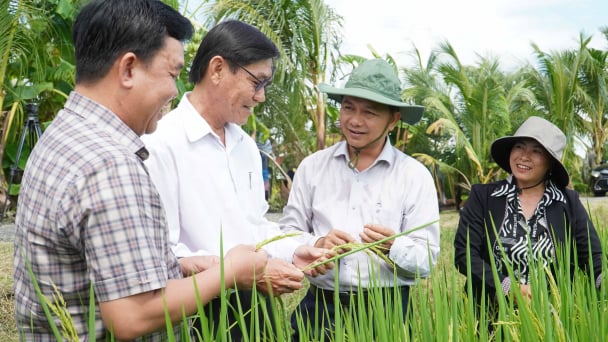
(VAN) Soc Trang's success in rice exports stems from a strategy of developing fragrant and specialty rice cultivation areas and standardizing production toward low-emission practices.
/2025/06/11/1311-5-120811_839.jpg)
(VAN) The pig farming industry is facing the challenge of comprehensive restructuring to meet requirements for quality, safety, traceability, and market expansion both domestically and for export.
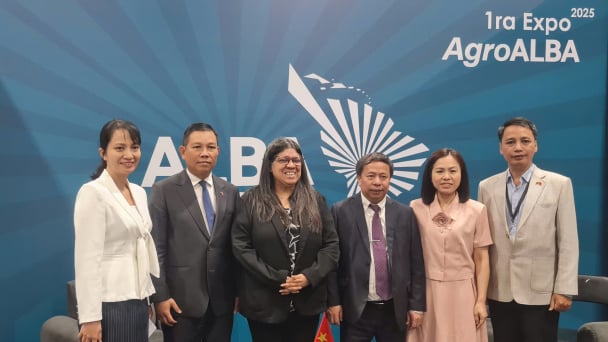
(VAN) Vietnam considers participating in ALGROALBA in order to expand agricultural production, coordinate the assessment and effective exploitation potential land.
/2025/06/05/5314-1-184727_407.jpg)
(VAN) From seemingly worthless fish scales and skin, enzymes and lactic ferments can transform by-products into peptides, opening a sustainable, effective business direction and elevating Vietnamese seafood.
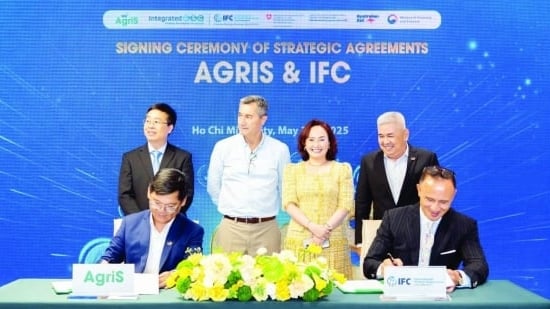
(VAN) TTC AgriS and IFC signed a strategic partnership to develop a sustainable agricultural value chain, aiming to achieve the Net Zero target by 2035.